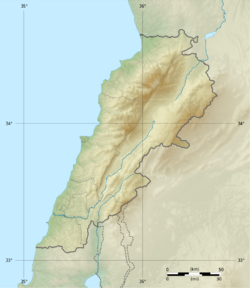Gibelacar facts for kids
Quick facts for kids Gibelacar (Hisn Ibn Akkar) |
|
|---|---|
| Akkar District, Akkar Governorate, Lebanon | |
| Coordinates | 34°31′30″N 36°14′30″E / 34.5250°N 36.2417°E |
| Site information | |
| Condition | Ruined |
| Site history | |
| Built | ca. 1000 (first construction) |
| Built by | Muhriz ibn Akkar (first construction) |
Gibelacar is an old fortress in northern Lebanon. It is also known by its original Arabic name, Hisn Ibn Akkar. Today, people sometimes call it Qal'at Akkar. This fortress is found in the village of Akkar al-Atiqa.
Gibelacar was first built around the year 1000, during the time of the Fatimid Caliphate. Later, in the early 1100s, it was taken over by the Crusaders. They used it for many years. Then, in the late 1200s, the Mamluks captured it and made it even stronger. For a long time, it was the main base for the Sayfa family. They were important governors and tax collectors in the area from the late 1500s to the mid-1600s.
Contents
Where is Gibelacar?
Gibelacar is located in a mountainous area called Jabal Akkar. This is the northern part of the Mount Lebanon mountain range. The fortress is about 27 kilometers south of a famous castle in Syria called Krak des Chevaliers.
Gibelacar sits on a narrow ridge, which is like a long, raised strip of land. This ridge is surrounded by two deep valleys with a stream called Nahr Akkar. Most of the fortress is now in ruins, but its remains stretch for about 200 meters along the ridge. The main tower at the southern end is still in good condition. The fortress is about 700 meters above sea level. From here, it has a great view of the mountain road leading up to it.
History of the Fortress
Early Arab History
The Arabs called this fortress Hisn Ibn Akkar. It was very important because it guarded a key mountain pass known as the Homs Gap. This pass connected the city of Homs to Tripoli.
According to old Arab writings, a man named Muhriz ibn Akkar built the fortress around the year 1000. His family owned it until 1019. Later, in 1024, a powerful leader named Salih ibn Mirdas took control of it. He was the head of the Banu Kilab tribe.
The Fatimid Caliphate got the fortress back in 1033. This happened after their army defeated Salih's tribe. In 1094, the Seljuk ruler of Damascus, Tutush I, captured the fortress.
Crusader Control
When the Crusaders arrived in the early 1100s, Hisn Ibn Akkar was controlled by Tughtakin, the ruler of Damascus. The Crusaders took over Tripoli in 1109. To stop them from attacking another important fortress, Tughtakin gave Hisn Ibn Akkar to the Crusaders.
The Crusaders started calling it Guibelacard around 1143. Later, in 1170, its name officially became Gibelacar. For much of the early 12th century, a powerful Crusader family called the Puylaurens controlled Gibelacar. It was their main base until about 1167, when Nur ad-Din captured it.
In 1169 or 1170, the Crusaders recaptured Gibelacar. However, a huge earthquake hit the area in 1170 and badly damaged the fortress. After the earthquake, King Amalric I of Jerusalem gave control of Gibelacar to the Knights Hospitallers. He told them to rebuild its defenses.
At the start of the 1200s, control of Gibelacar went to a Crusader lord named Raynouard III. He got it through his marriage in 1203 or 1204. However, this transfer caused a civil war because Raynouard's lord, Bohemond IV of Antioch, did not approve. Bohemond eventually took Gibelacar in 1205.
Mamluk Capture
The fortress stayed with Bohemond IV's family until the Mamluk sultan Baybars captured it. This happened soon after he took the Krak des Chevaliers in April 1271.
Baybars himself led his army to Gibelacar on April 28. It was hard to move their large siege machines through the mountains. The Mamluks began attacking on May 2. The defenders fought bravely, but they were almost defeated by May 4. They finally surrendered on May 11. In return, they were allowed to leave safely for Tripoli. Baybars had his special leopard symbol carved onto the main tower of Gibelacar.
Sayfa Clan Headquarters
In the 1520s, a man named Yusuf Sayfa and his family settled in Hisn Ibn Akkar. By this time, the fortress had become the center of its own village. From here, the Sayfa family grew powerful. They were first under the control of other local lords.
In 1579, Yusuf was made governor of a new province called an eyalet, based in Tripoli. He became more independent. Hisn Ibn Akkar was a good base because it was easy for the Ottoman Empire to reach it through the Homs Gap. This meant the Ottomans could keep an eye on Yusuf.
In 1585, the Ottoman army attacked Hisn Ibn Akkar as part of a larger campaign. After this, the Sayfa family had to pay taxes to another family again. However, Yusuf had the last leader of that family killed in 1590.
See also
 In Spanish: Gibelacar para niños
In Spanish: Gibelacar para niños


